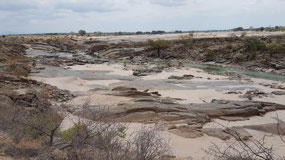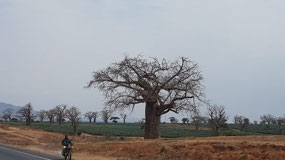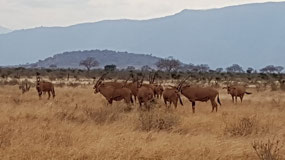The night is interrupted various times by the sound of elephants, and in the morning it turns out that a small elephant has broken a faucet looking for water.
During breakfast we discuss the plans for today and tomorrow. Didi really wants to explore the north of the park, so we decide to leave the tents and spend another night here if we cannot finish this park today.
We pass the site of the lion hunt and see the carcass of the buffalo, and still some lions in the area.
We follow the Voi river, hoping to see some animals near the water, but the dry season has left no water visible.
The landscape is fine for spotting animals, with many bushes, some taller trees, mostly overgrown with vines at the bottom, leaving lots of hollow spaces around the stem where animals can hide, hidden by the vines.
But the amount of animals disappoints. Apparently it is too dry. We see some gazelle, impala and a distant elephant, but after several hours not much more. Surprising is the absence of dik-dik. Tsavo West was full of them, but here hardly any.
Tsavo West has a much denser vegetation than Tsavo East, maybe that explains.
We visit the site of a dam, but all is bone dry. Then we cross the plane to a river in the north, and for an hour we see only dried up shrubs and giant blood red termite hills. Some of them are taller than I.
At some point our track joins a dried up river that must be paradise when there is water: rows of palm trees line the river bed. Large slabs of stone, now baking in the sun, must make playful waterfalls. The soil is red and the stones a kind of pink. It must be beautiful when the water returns.
Suddenly we see seven giraffes - there must be water somewhere!
Another half hour later we reach the Palaga (?) river, with just a fraction of it's bed filled with water. The river is over 100 meter (300 ft) wide, but just a a small crack - still causing a distant roar when it passes through rapids - contains water.
From a high position, we have a lofty view over a wide stretch of the river.
The land is baking in the sun. Every shrub seems dead.
Deep below us on sandbanks we see crocodiles basking in the sunshine. Dark spots in the water reveal hippos.
As I walk lizards shoot around my feet. I keep a careful view around me for snakes.
Yesterday night I was brushing my teeth at the campground. Facilities are somewhat primitive. The bathroom has a screen door to prevent monkeys from entering.
While brushing my eye catches a movement on my right in a dark corner. I jump: it's a long black snake, on the ground, moving towards me.
Obviously the snake watches me, for it responds to my movements. Sisi appears and films the snake before it slides under the screen door and disappears outside.
This morning Hamisi, who got us some firewood, tells us it was a black mamba.
I have a hard time believing it: the most toxic snake in Africa? Disturbing my evening toilet? I have some tough stories to tell back in Europe!
There is one other family on the campground, a white family that has ancestors in Kenya since the late 1800's. They know every nook and cranny in East Africa. We show the picture, and my tough story evaporates: "common house snake, not dangerous.
.."
Still, the black mamba is in my mind, just like the puff adder, responsible for most deadly snake bites in Africa, so I watch where I step.
We enjoy the land, even with few animals, and late afternoon we return to the camp.
We decide to sleep in a hotel outside the gate because tomorrow we want to depart early for Nairobi and lake Navaisha (and because it costs only 1/3 the price of another 24 hour permit for the park.)
We leave the park and enter the hectic town just outside, where hundreds of people sell everything from shacks in the market place.
After checking into the hotel, Sisi and I do a little grocery shopping. Everything is very poor here, but functional. I see young women coming out of a dilapidated shack shaking with rhythmic music. Then I see the sign 'gym' painted on the door. In the market are stores too small to enter for electric supplies, butcher, chemist (pharmacy), vegetables etc.
The people are very poor, but in their poverty still name everything as we do in the West.
In a bed with klambu (mosquito net) we fall asleep.
By the way, there are no trash cans in Kenya. People do not know what it is. However, they do have dust bins.
Neither are there any bathrooms. But fortunately they do have wash rooms.

 Tsavo East National Park, Makueni County, Kenya
Tsavo East National Park, Makueni County, Kenya








2025-05-23